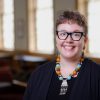This article is more than 5 years old.
Much of my ALA experience in New Orleans can be summarized in a list of “firsts”:
– first time at an ALA Annual conference (Midwinter was my first ALA anything!);
– first time presenting at a poster presentation (which I did twice!);
– first time attending a full ACRL Scholarly Communications Committee meeting (long (4 hours) but fascinating);
– first time the ACRL Scholarly Communication 101 Road Show program presenters met in person (for a very productive day-long curriculum planning retreat);
– first time touching an alligator (just a baby one…);
– first time eating a beignet (YUM);
– first time in NOLA (amazing).
As I continue to be involved with ALA and ACRL, I know that many of these firsts will be followed by seconds, thirds and so on, but happily they all combined this year for an overwhelmingly positive conference experience!
The most important reason I attended this ALA (and no, it wasn’t food-related, Facebook photos notwithstanding) was to complete my participation in the Emerging Leaders (EL) program. On Friday, our EL class had a morning leadership training and assessment session, followed by a lunch and “graduation” ceremony, then concluded the program with our afternoon poster session. The posters were outcomes of our six months’ project work, and I thought that all 16 teams did a great job designing interesting, engaging posters. As you might expect, there were a lot of QR codes around (our team used one), as well as Mardi Gras beads, buttons and other goodies to entice people to visit teams’ posters and learn more about our projects.
My EL project team (Team L) was tasked this past winter and spring with completing a webinar series feasibility study for the ALA Learning Round Table (LearnRT) board, which is launching a new Webinar Learning Series later this year. We began our research by identifying many webinar and e-learning series currently and previously in place, and then selecting 16 to assess on a number of criteria that included cost, timing, theme, platform, and promotion. After analyzing the collected data, we contacted organizers of 10 webinar series asking them to complete a detailed webinar assessment survey. The aim of the survey was to gain insight into elements of webinar series production that are less easily quantified or not publicly available (e.g., best practices, planning timelines, number of registrants or attendees, etc.). From the data we gathered and from that provided by the survey respondents (50% response rate), we drafted a report for the LearnRT board that outlines best practices, issues and implications for success, and recommendations for the new webinar series. We submitted our report to the LearnRT board prior to ALA, and several board members came to our poster session to thank us in person for doing a great job. If interested, you can read our report at our team’s ALA Connect page (and certainly ask me questions!).
As mentioned above, the EL poster session was just one of two I co-presented at ALA, but both involved our EL project poster. On Sunday afternoon, we rolled out our poster again at the annual LearnRT training showcase. Although we had lots of traffic and interest at Friday’s EL poster session, including Lauren P. and Steve, the folks we chatted with on Sunday were a more targeted audience, asking in-depth questions about our research and findings. I was very glad that LearnRT invited us to participate in the showcase, and look forward to the launch of the Webinar Learning Series as an outgrowth of our EL work.
Much of the rest of my ALA was spent at various scholarly communication-related presentations and meetings. The Road Show planning retreat was held on Thursday, the day before the conference started, so by the time Saturday morning rolled around, I’d already had two full days of activities. I did not slow much over the weekend, but fortunately didn’t have to dash between the convention center and hotels too often. I attended sessions covering library-university press partnerships, the Berlin Declaration on Open Access and the Berlin9 conference (to be held in the US for the first time this fall), and two on how best to advance scholarly communication and open access conversations on campuses. I was *thrilled* to attend one session on these issues sponsored by someone other than SPARC, the ACRL SC Committee, or the ALCTS SC Interest Group: on Monday morning, the ACRL Women and Gender Studies Section organized a panel addressing “21st Century Scholarly Communication: Conversation for Change.” I was very impressed by one panelist who unabashedly owned the failure of an open access journal she launched as a graduate student, as I believe that success and failure must be acknowledged, as both provide learning opportunities.
I’ve returned from ALA where I “emerged” officially, ate too much phenomenal food and became smitten with NOLA, but most importantly with lots of interesting ideas bouncing around my brain, not the least of which are some programming ideas for Open Access Week in October. Stay tuned!

2 Comments on ‘Molly “Emerged” at ALA’
Congratulations!
Congrats and great work!